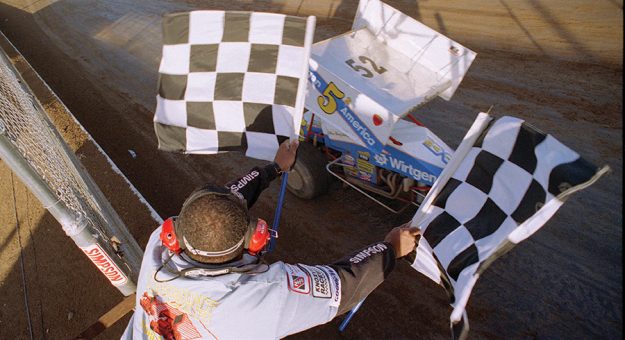One does not have to gaze into the crystal ball for long to predict the media landscape will continue to evolve rapidly and move in unforeseen directions. Today with the right tools at your disposal if you wish to hear a favorite song all it takes is to make the request with your voice.
One does not have to gaze into the crystal ball for long to predict the media landscape will continue to evolve rapidly and move in unforeseen directions. Today with the right tools at your disposal if you wish to hear a favorite song all it takes is to make the request with your voice.
It‘s a world where we‘ve grown accustomed to having instant news and the ability to watch hundreds of races on streaming video at our fingertips.
In so many ways the chance to catch live events nearly anywhere across the globe is miraculous. However, what seems nearly unfathomable now will seem rudimentary in the future.
Which brings us to the 30th anniversary of the Slick 50 Sprint Car World Series.

When it was announced that fans would be treated to live dirt sprint car racing in the dead of winter there was cause to rejoice. In fact, few could believe it was really happening. The series was a product of a unique time and place, but was decidedly trailblazing.
When we take a glimpse back in racing history it is easy to get tunnel vision and focus solely on the competition. The question of who won and lost is important, but in this instance the story goes much deeper. As a result of this series lives were changed and one could make the case that sprint car
racing came of age.
When Pat Patterson, now a well-known racing personality reflects on his career he claims he “has always been a sales guy.” Based in Charlotte, Patterson owned a small radio and television production company and was under contract with The Nashville Network. He was already well-versed in pushing the envelope, as evidenced by his innovative show RaceDay.
His arrangement with TNN was unique.
“Unlike a lot of other contractors I had a barter deal,” Patterson explained. “In other words, I had to go and sell my own advertising time. All TNN did was provide me a time slot and it was up to me to bring them a show. We covered NASCAR, but one of the things we did Saturdays and Sundays was get the highlights from the late Greg Stephens. He was the man. He was out there running with Ted Johnson and the World of Outlaws or USAC and getting tapes to us in order for us to put them on the show. We were avidly covering sprint car racing every week.”
As hard as it is now to grasp, what Patterson and his crew were doing was cutting edge.
“RaceDay was the first show that utilized live shots from race tracks,” Patterson said. “So if the NHRA was racing in Dallas we would say let‘s go live to the Texas Motorplex and talk to John Force. At the time nobody was doing anything like that. We were the first to make that sort of thing work on a
regular pre-race show.”

TNN had moved into NHRA coverage and was certainly interested in expanding its NASCAR inventory, but Patterson had his eye on those months between the end of the season and when things cranked up again at Daytona.
In the early 1990s racing was not a yearlong proposition. With his mind churning he asked Stephens a simple question. “I asked Greg if these sprint car guys are ever on live television,”
Patterson said.
Stephens didn‘t mince words. “No,” the future National Sprint Car Hall of Famer responded, “and that‘s never going to happen.”
When pressed, Stephens proclaimed that there would be scant interest, the dust involved in dirt racing was a significant production obstacle and most tracks had terrible lighting.
Still Patterson continued to pursue the matter of putting sprint car racing on live television.
“I kept having conversations about this because I thought, and I still think this today, that sprint car racing is one of the most bad-ass forms of motorsports on the planet,” Patterson said.
No matter how strong his desire burned to make things happen he knew he faced an uphill climb. Given his pre-existing arrangement with TNN he knew it was up to him to get sponsors on board. It wasn‘t like he was holding a blank check, but because of the success of RaceDay he felt he had enough tokens in his pocket to approach TNN executive David Hall.
